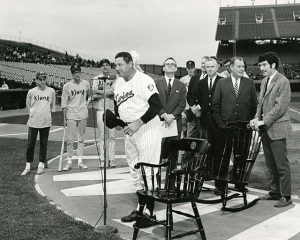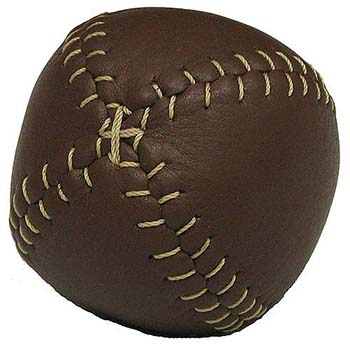 No, I wasn’t there, but I can imagine “Thwack!” was the sound of ball hitting bat in 19th century “base ball” (two words) which became known as our national pastime, played in almost every town. The sound was definitely not the “Clunk!” or “Ping!” of metal since bats were made of lumber. The first balls were handmade, of variable weights, with a core wound with yarn or string and some stuffing, with a one-piece stitched cover of brown leather. No helmets, masks or gloves were worn by the players. And the rules were quite different from the game we see the Twins play today. For more about that, check out the website 19cbaseball.com or attend a vintage “base ball” game in person (see sidebar on Northfield’s Silver Stars). Return with me now to those early days of “base ball,” henceforth to be (mostly) written as one word for this story.
No, I wasn’t there, but I can imagine “Thwack!” was the sound of ball hitting bat in 19th century “base ball” (two words) which became known as our national pastime, played in almost every town. The sound was definitely not the “Clunk!” or “Ping!” of metal since bats were made of lumber. The first balls were handmade, of variable weights, with a core wound with yarn or string and some stuffing, with a one-piece stitched cover of brown leather. No helmets, masks or gloves were worn by the players. And the rules were quite different from the game we see the Twins play today. For more about that, check out the website 19cbaseball.com or attend a vintage “base ball” game in person (see sidebar on Northfield’s Silver Stars). Return with me now to those early days of “base ball,” henceforth to be (mostly) written as one word for this story.

First, I must debunk the notion that Abner Doubleday (1819-93), a Union general, invented baseball in 1839 in Coopers-town, N.Y. (now home of the Baseball Hall of Fame). This claim was made for him, years after his death, by a panel eager to assert that baseball was America’s own game. In fact, baseball shares connections with bat and ball games such as cricket and rounders in England, which had developed from earlier folk games. Rules for the game as played in the U.S. were first established by the Knickerbockers Club of New York in 1845 and defined further at a convention of clubs held in New York in 1857.
Minnesota’s short-lived first team was organized on Aug. 8, 1857, in Dakota County in Nininger City north of Hastings (now existing as the name of a township). When Minnesota became a state in 1858, the capital city of St. Paul fostered growth of the game. Then, when the Civil War broke out in April of 1861 at Ft. Sumter, soldiers carried bats along with equipment of war and played baseball for recreation in training camps, war prisons, even on front lines. After the armies were demobilized in 1865, baseball clubs sprang up anew, including the North Star Base Ball Club, formed in St. Paul on May 9, 1865, whose president and pitcher, Rollin Olin, later became a banker and mayor of Owatonna. (This team promptly took on the Excelsior Club of Ft. Snelling in a home match, winning 38-14, and defeated the new Vermillion club in Hastings 55-21 on July 1.)
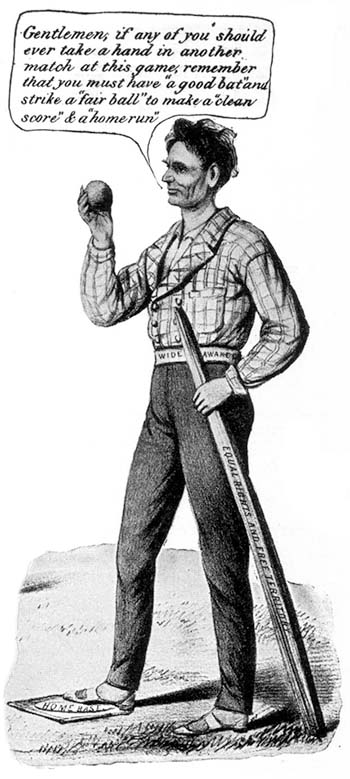
Faribault welcomed organized baseball in the spring of 1867 with the creation of the Faribault Base Ball Club, as reported on April 17 in the Central Republican. On July 3, 1867, the newspaper wrote, approvingly, “The game of base ball is one calculated to develop vigor and manly grace, and the boys who choose to practice this healthful amusement will be spending their time to much better advantage than if they were dawdling in the streets, learning to chew tobacco and smoke cigars or watching billiard playing in the saloons.” The editor of the Lake City Leader wrote on Aug. 23, 1867, “The game of Base Ball has become so much the style that nearly every village and hamlet has its club, and to be a member of the first nine is now looked upon as being nearly as honorable a position as a seat in the Legislature.”
On Sept. 4, 1867, a club convention was held in St. Paul to form the Minnesota State Association of Base Ball Players. Stew Thornley, in Baseball in Minnesota (Minnesota Historical Society Press, 2006), lists charter members as the North Star Club of St. Paul, the Adriatic of Dundas, Vermillion of Hastings, Union of Lake City, Minnehaha of Northfield, Gopher of Owatonna, Crescent of Red Wing, Arctic of St. Cloud and a Faribault team, with two clubs from Minneapolis (one a junior club). The North Stars won a silver ball symbolic of a state championship in a tournament of five clubs later that month.
The North Stars were challenged by Northfield’s Minnehaha Club after defeating Faribault, Hastings and Hudson, WI, in 1868. The first game, held on July 17 before 700 spectators in St. Paul, started with controversy as the umpire rejected St. Paul’s plans to use William Miller of the St. Croix team of Stillwater as pitcher. (It was claimed he was moving to St. Paul.) The St. Paul Dispatch account on July 18, 1868, said the last innings were played “in a blinding rain, amid peals of thunder and flashes of lightning,” which made everything “unnaturally light for a few seconds, and then leaving everything in darkness.” The players, “daubed from head to foot with mud,” played with a slippery ball and with bats which “frequently slipped from the hands of the batters,” almost hitting those who “stood shivering under water-soaked umbrellas” and scorers who were “crouched under the tables” to escape the drenching rain. The umpire stopped the game in the midst of the seventh inning, very much to the disgust of the North Stars, who desired to have it go on, “though the heavens should fall.” The North Stars “went to their Waterloo” 77-38, suffering their “first defeat since their organization.”
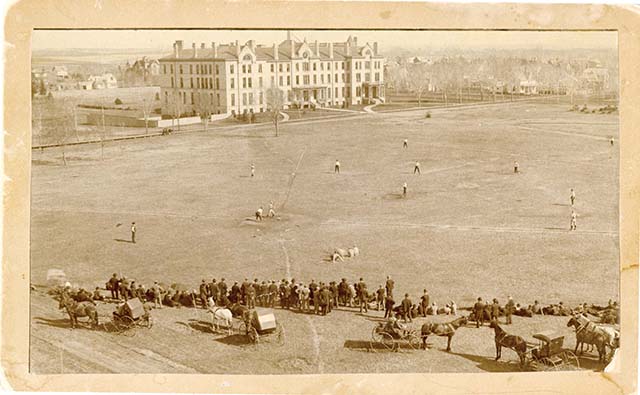

Minnehaha then beat the North Stars again in Northfield on Aug. 14, by a score of 40-38. But on Sept. 23, Minnehaha lost at home to the St. Croix Club of Stillwater, which kept the silver ball until July of 1869. By 1870, a Northfield team called the Silver Stars was state champion. The Minneapolis Unions came to Northfield to help inaugurate the new Silver Star Park on Sept. 3, 1875, and were defeated 35-10 before a crowd of 400 (admission: 25 cents). The Rice County Journal wrote on Sept. 8 that the “brilliant success” of the Silver Stars has “dampened the ardor” of other clubs to play them.
One team that did provide a challenge that fall was the Winona Clippers, who split games with the Silver Stars, losing 14-5 on Sept. 6 and winning 8-1 on Sept. 8. The Clippers had used a black player, W.W. Fisher, as a pitcher/second baseman, recruited from a Chicago team. The Rice County Journal of Aug. 4 had commented about having heard the “hint” that the Clippers had “secured from the east” professionals but, “We don’t believe Winona boys would resort to any such dishonest means to win the game.” Before the Sept. 6 game, members of the Silver Stars wore racially derogatory emblems in protest, which was acknowledged by the Northfield Standard on Sept. 23 as having been in “bad taste.”
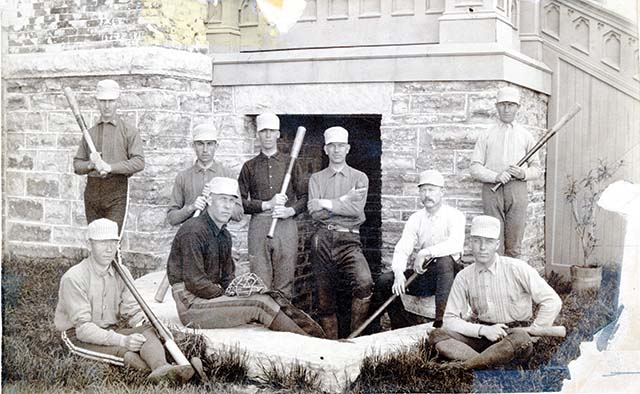
Controversies continued, but views on being paid to play were changing. On July 18 of 1876, the newly formed Minneapolis Blue Stockings Club played what was called its “first professional game” at home against the champion Silver Stars, winning 12-10. Later in the summer, Northfield’s team won a return game 23-5, then went to Hastings to help open a new ball ground there.
There is no record of the Northfield team having played at the time of the James-Younger bank robbery in Northfield on Sept. 7, 1876, though a game was recreated in the 1972 movie, The Great Northfield Minnesota Raid. Cliff Robertson plays Cole Younger who, posing as a visiting cattleman, attends a local baseball game between Northfield and St. Paul (with a majestic mountain range in the background). When Cole is told “Baseball is our national sport,” Cole replies, “Our national sport is shooting and it always will be” and he proceeds to shoot the ball out of the sky with his rifle to end the game. (Coincidentally, Rice County Sheriff Ara Barton, who took charge of the James-Younger Gang after they were captured, was vice president of a baseball club at the time.)
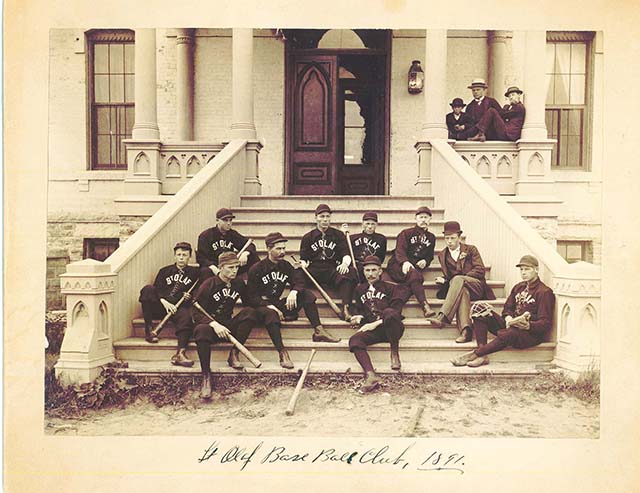
Baseball games between schools began in earnest in the 1880s. In June of 1880, the Carletonian lamented, “Athletic sports do not flourish at Carleton.” While “the baseball nine was for a short time revived,” it soon expired. “Leapfrog was for a time all the rage, but as warm weather came it too was too exhausting.” But Carleton was soon to play baseball games with Northfield High School, Pillsbury Academy of Owatonna, Shattuck Military School, Seabury Seminary, the Minnesota School for the Deaf in Faribault and occasionally with the University of Minnesota. And in 1887, heated games began with crosstown rival St. Olaf College.
In 1882, Carleton sent a challenge to the University of Minnesota to play a game of baseball. On Sept. 25, as described in Carleton: The First Century (Headley and Jarchow, 1966), “a motley crew composed of two or three University students, several black-balled professionals, a barber, and a few Minneapolis bummers came down to Northfield and represented themselves as the University nine.” The alleged “University boys” won 13-9. In May of 1885, Carleton lost a game at the University 26-7.
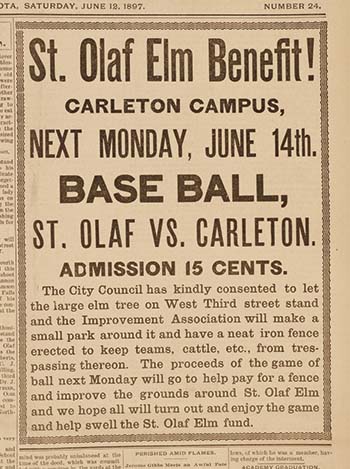
St. Olaf’s first baseball team was formed in the spring of 1887, with Carleton as its opponent on May 14. St. Olaf Associate Archivist Jeff Sauve described the “far from ideal” playing field in the Fall 2014 St. Olaf Magazine. It was located “at the foot of the hill below Old Main on the southeast side of the campus. A raised wooden walkway traversed the outfield for students to climb the hill. More than once, the game paused for the retrieval of a batted ball that had rolled under the walkway. A barbed wire fence across the road served as backstop.” Carleton prevailed 25-20 and won another game 14-11 on May 16 at Carleton.
A.G. Bjorneby, Class of 1892, wrote in the Quarter Centennial 1874-1899 Souvenir of St. Olaf College that the losses were due to his team facing a curve ball for the first time. By the second season of 1888, Ole pitcher C.J. Rollefson had mastered the curve and St. Olaf beat Carleton three times, 18-12, 9-7 and 14-13. Bjorneby said that on May 17, St. Olaf defeated the Silver Stars, “once the pride of Northfield and champions of the state.” Another victory of this undefeated season came over the Randolph team, 13-5. Emboldened, the team bought new uniforms for the 1889 season. Losses (including two to the strong Shattuck team) were attributed by the Manitou Messenger to “anxiety to keep the suits neat and clean.”
Sauve’s story relates how players had sought funds to buy 20 acres west and north of Ladies Hall for a baseball diamond (comprising the lawn of Agnes Mellby Hall and a good part of Norway Valley today). With hard labor, nearly all of the 69 enrolled male students who played on seven campus baseball clubs cleared timber, removed stumps and graded the field to prepare for the inaugural game on the grounds against Carleton on May 16, 1890. The Oles won 11-9, despite Carleton scoring five runs at the top of the ninth. Carleton could console themselves with having won 16-3 at home earlier that week.
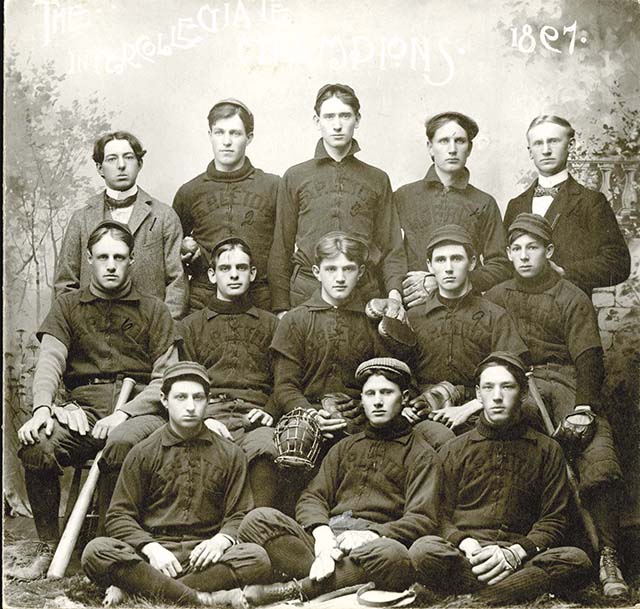
In February of 1891, the Southern Minnesota Inter-Collegiate Base Ball League was formed with St. Olaf, Carleton, Pillsbury and Shattuck playing each other twice. St. Olaf won all six of its games and took the first pennant. Two games played in May were particularly tumultuous, according to the Northfield News of May 16, 1891. Carleton defeated Pillsbury 8-7 in Owatonna on May 11, but the newspaper protested the “outrageous treatment” by the “Pillsbury Nine” that had “hissed and yelled at our plays and tried every device that malice and desperation would suggest to confuse our boys.” (Carleton’s manager said it was good practice for his team to hold their tempers.) St. Olaf then won its first game on May 13, defeating Shattuck of Faribault 4-0. Although St. Olaf won, it was later claimed that “the umpire had a bet of $10 that the Shattuck club would win the game.” Also, the “boisterous and rowdyish conduct” of some of the Shattuck followers during the game was criticized.
On July 13, 1892, the Trustees of St. Olaf’s Board received a letter from five faculty members which included the complaint that there was “too much baseball playing.” President Thor-bjørn Mohn upheld baseball in May of 1893, telling students the game was “an instrument for improvement both mentally and physically rather than for testing the yelling capacity of both players and spectators.” In early years, professors even played on the teams. Prof. Halvor Ytterboe, the regular first baseman, extolled athletics for developing character and providing needed exercise.

Though Carleton joined a baseball league with Hamline and Macalester in March of 1893, interest in the sport declined for a time. The highlight of baseball in 1894 was when Carleton’s freshman class rejoiced in defeating the sophomores 27-13. Carleton’s varsity barely got by Northfield High School’s team 6-5 in a six-inning practice game that May.
Northfield High School’s team tied St. Olaf 5-5 in five innings of play in April of 1895, the same year NHS lost at home to South Side High School of Minneapolis and to Shattuck. However, NHS won two games against Mankato and had good prospects for 1896, the year that an unlikely powerhouse team emerged in town.
The Northfield News of April 25, 1896, rhapsodized, “As the warm sunshine brings from mother earth the emerald carpet, lovers of outdoor sport grasp the first opportunity to commence their favorite game. In Northfield, the game that is almost universally played is base ball…” The story noted that the Washington grade school team had already won two games. On April 11, the grade schoolers defeated Northfield High School 16-8, then defeated NHS again that season 18-12 and 18-2. They also beat a team from Carleton 20-7. (It must be noted that 8th graders played at the elementary level back then, but still…)
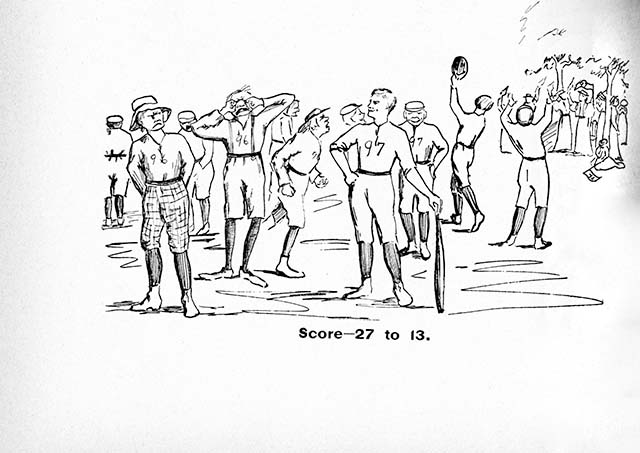
The “big game” in Northfield in 1897 involved a giant elm tree located where West Third Street met Forest Avenue. This tree had been saved from being felled a couple years earlier by tree-loving community members. St. Olaf professor Andrew Fossum lived nearby and convinced the city council to “set aside the little triangle on which the tree stood as a city park,” according to Harvey Stork, in Trees of Northfield (1948). Stork wrote, “With his victory, the smallest city park in the country was born.” Fossum arranged a benefit baseball game between St. Olaf and Carleton at Carleton on June 14, 1897, to finance an iron fence around the tree and to “improve the grounds” around the “St. Olaf Elm.” Carleton won the game 11-8, concluding a winless season for St. Olaf and capping an intercollegiate championship year for Carleton. The Sept. 11, 1897, Northfield News recorded the city council’s ordinance for “the care and protection” of the tree, with provisions for a railing and fines and/or imprisonment of anyone who should “cut, injure or deface said St. Olaf Elm.” The tree finally was brought down in January of 1921 as a safety hazard, after three weeks of cutting due to its enormous size.
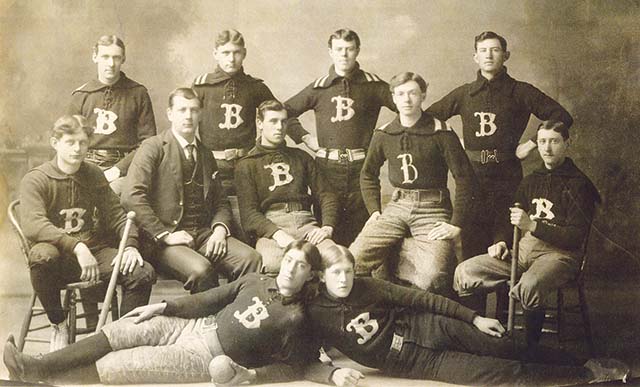
People were already looking back with nostalgia on the game at the turn of the century. The Northfield News of May 12, 1900, announced, “Some of our local base ball enthusiasts are becoming so intensely interested in the good old game that they cannot keep off the diamond and have arranged for a red hot game on Carleton campus next Wed., weather permitting.” Teams were divided as East Side of Division Street vs. West Side and each side would have an attending physician. Among the East Siders were Stuart Sumner as catcher and W.F. Schilling at center field. John Bierman played left field for the West. The story said the game would be interesting, as some of the players were “stars in the early eighties when ball was played without gloves.” The May 19 Northfield News reported the result: a 31-13 victory for the East Side. Harry Gress kept up the enthusiasm he had felt from the days when he played first base for the Silver Stars. Now weighing more than 200 pounds, he nevertheless ran around the diamond “like a cat up a cherry tree.” John Bierman “made some good runs in left field.” The game was only briefly delayed when the ball was “extracted from the mouth of a white dog with black spots.”
It sounds like the sort of game that today’s Northfield vintage Silver Stars would have enjoyed.
Silver Stars Play Vintage Base Ball Today
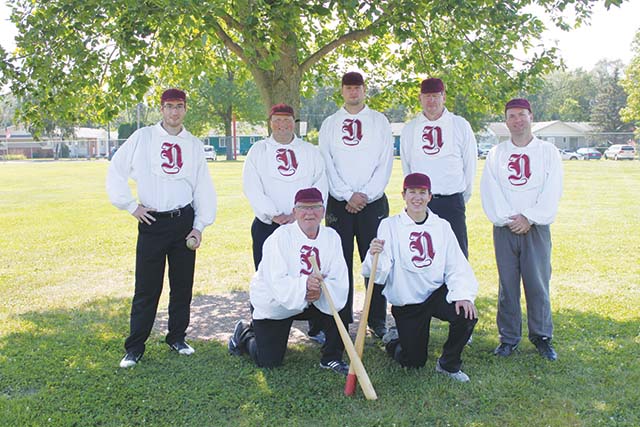
The vintage Silver Stars Club grew from a team recruited by Scott Richardson for a game with the vintage St. Croix Base Ball Club of Stillwater in 2003 to promote the state amateur baseball tournament co-hosted by Northfield and Dundas. The aging “boys of summer” enjoyed the experience and formed a permanent team in 2004. Dan Hagen is the last remaining member of that 2004 team. Hagen, who took over for founder, manager and captain Scott “Rabbit” Richardson after the 2014 season, told me the team gradually became “truly cross-generational with octogenarians playing alongside teenagers, and we started to win games.”
Hagen told me that historically games were played between clubs who paid dues, but there were also so-called “muffin games,” of “married vs. single, skinny vs. fat, facial-hair vs. clean-shaven” and east vs. west side of a street (as in 1900 in Northfield). Those who play “vintage base ball” try to recreate the early game “with as much historical accuracy as possible,” interpreting what has been written. More than half of the rules are the same as the modern game, but “it is likely early players relied more on placement hitting and aggressive base-running” than home runs. Hagen made the point that one can watch a vintage game and recognize it is baseball or, as a little boy was once heard to say, “Look, Daddy! A bunch of grandpas trying to play baseball!”
There is a difference in terminology. For instance, batters were called strikers, pitchers (who could only throw underhand) were hurlers, a fast ground ball was a daisy cutter and a high fly ball was a balloon. Vintage players have to adjust to playing bare-handed without gloves, although an out can be made by catching a ball which bounces once. Hagen said, “Early players were admonished for not catching it like a man!” before a bounce.


